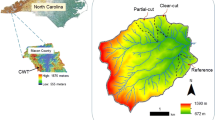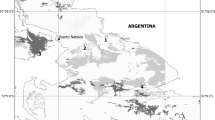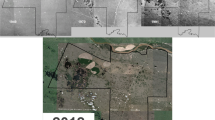Abstract
Forested wetlands are important ecosystems valued for their indigenous plant communities, spatial heterogeneity, wildlife habitat, water quality, and timber resources. When harvested for timber, plant composition in these wetlands may change due to alteration in microsite habitats. Harvest severity also may affect plant composition. In this study, a mineral conifer wetland was subjected to whole-tree harvesting followed by installing different site preparations (bedding, trenching, draining). The original wetland overstory was Picea mariana, Larix laricina, and Pinus banksiana, with groundcover dominated by Sphagnum russowii. Eleven to twelve years after harvest, we assessed responses of vascular and non-vascular plants to created microtopographies (pits, side slopes, mounds) to determine whether harvest severity affected species richness, diversity, and relative cover of plant communities. For all the microtopography positions, the more severe harvest treatments (drained, cut, trenched) had the highest plant richness but the lowest diversity values. Richness and relative cover of Sphagnum species were highest in reference areas and much lower in the most severe harvest treatments (drained, cut, trenched). In contrast, graminoid and, to a lesser extent, herbaceous and woody plants increased in richness and cover after harvest.
Similar content being viewed by others
Literature Cited
Albert, D. A., S. R. Denton, and B. V. Barnes. 1986. Regional landscape ecosystems of Michigan. School of Natural Research, Ann Arbor, MI, USA.
Andersson, L. I. and H. Hytteborn. 1991. Bryophytes and decaying wood — a comparison between managed and natural forest. Holarctic Ecology 14: 121–30.
Beatty, S. W. and E. L. Stone. 1986. The variety of soil microsites created by tree falls. Canadian Journal of Forest Research 16: 539–48.
Berg, A., B. Ehnstrom, L. Gustafsson, T. Hallingback, M. Jonsell, and J. Weslien. 1994. Threatened plant, animal, and fungus species in Swedish forests: distribution and habitat associations. Conservation Biology 8: 718–31.
Bray, W. L. 1956. Gap-phase replacement in a maple-basswood forest. Ecology 37: 598–600.
Brokaw, N. V. L. 1985. Treefalls, regrowth, and community structure in tropical forests. p. 53–69. In T. A. Pickett and P. S. White (eds.) The Ecology of Natural Disturbance and Patch Dynamics. Academic Press, Orlando, FL, USA.
Chimner, R. A. and J. B. Hart. 1996. Hydrology and microtopography effects on northern white-cedar regeneration in Michigan Upper Peninsula. Canadian Journal of Forest Research 26: 389–93.
Connell, J. H. 1978. Diversity in tropical rain forests and coral reefs. Science 199: 1302–10.
Crawley, M. J. 1986. The structure of plant communities. p. 1–50. In M. J. Crawley (ed.) Plant Ecology. Blackwell, London, UK.
Crum, H. 1991. Liverworts and hornworts of southern Michigan. The University of Michigan Herbarium, Ann Arbor, MI, USA.
Crum, H. A. and L. E. Anderson. 1981. Mosses of Eastern North America. Volumes 1 and 2. Columbia University Press, New York, NY, USA.
Denslow, J. D. 1980. Patterns of plant species diversity during succession under different disturbance regimes. Oecologia 46: 18–21.
During, H. J. 1979. Life strategies of bryophytes: a preliminary review. Lindbergia 5: 2–18.
During, H. J. and B. F. Van Tooren. 1990. Bryophyte interactions with other plants. Botanical Journal of the Linnean Society 104: 79–98.
Gale, M. R., J. W. McLaughlin, M. F. Jurgensen, C. C. Trettin, T. Soelsepp, and P. O. Lydon. 1998. Plant community responses to harvesting and post-harvesting manipulations in a Picea-Larix-Pinus wetland with a mineral substrate. Wetlands 18: 150–59.
Gleason, H. A. and A. Cronquist. 1991. Manual of Vascular Plants of Northeastern United States and Adjacent Canada, second edition. New York Botanical Garden, Bronx, NY, USA.
Gustafsson, L. and T. Hallingbäck. 1988. Bryophyte flora and vegetation of managed and virgin coniferous forests in southwest Sweden. Biological Conservation 44: 83–300.
Haeussler, S., L. Bedford, J. O. Boeteng, and A. MacKinnon. 1999. Plant community responses to mechanical site preparation in northern interior British Columbia. Canadian Journal of Forest Research 29: 1084–1100.
Halpern, C. B. and T. A. Spies. 1995. Plant species diversity in natural and managed forests of the Pacific Northwest. Ecological Applications 5: 913–34.
Hellquist, C. E. and G. E. Crow. 1999. The distribution of the bryophytes and vascular plants within Little Dollar Lake peatland, Mackinac County, Michigan. Rhodora 101: 46–86.
Hunter, M. L. 1990. Wildlife, Forests and Forestry: Principles of Managing Forests for Biological Diversity. Prentice Hall, Englewood Cliffs, NJ, USA.
Jonsson, B. G. and P. A. Esseen. 1990. Treefall disturbance maintains high bryophyte diversity in a boreal spruce forest. Journal of Ecology 78: 924–36.
Laine, J., H. Vasander, and R. Laiho. 1995. Long-term effects of water level drawdown on the vegetation of drained pine mires in southern Finland. Journal of Applied Ecology 32: 785–802.
Lesica, P., B. McCune, S. V. Cooper, and W. S. Hong. 1991. Differences in lichen and bryophyte communities between oldgrowth and managed second-growth forests in the Swan Valley, Montana. Canadian Journal of Botany 69: 1745–55.
Levin, S. A. and R. T. Paine. 1974. Disturbance, patch formation and community structure. Proceedings of the National Academy of Science USA 68: 1246–48.
Liechty, H. O., M. F. Jurgensen, G. D. Mroz, and M. R. Gale. 1997. Pit and mound topography and its influence on storage of carbon, nitrogen, and organic matter within an old-growth forest. Canadian Journal of Forest Research 27: 1992–97.
MacLean, D. A. and R. W. Wein. 1977. Changes in understory vegetation with increasing stand age in New Brunswick forests: species composition, cover, biomass, and nutrients. Canadian Journal of Botany 55: 2818–31.
Miller, T. E. 1982. Community diversity and interactions between the size and frequency of disturbance. American Midland Naturalist 4: 533–36.
Osman, R. W. 1977. The establishment and development of a marine epifaunal community. Ecological Monograph 47: 37–63.
Palisaar, J. and P. Poschlod. 2001. Bryophyte diversity in cleared and uncleared windthrow gaps and the adjacent forest stands in the Bavarian Forest National Park, SE Germany. Lindbergia 26: 46–54.
Peterson, C. J. and J. E. Campbell. 1993. Microsite differences and temporal change in plant communities of treefall pits and mounds in an old-growth forest. Bulletin of Torrey Botanical Club 4: 451–60.
Price, J. S. and G. S. Whitehead. 2001. Developing hydrologic thresholds for Sphagnum recolonization on an abandoned cutover bog. Wetlands 21: 32–40.
Raunkiaer, C. 1934. The life forms of plants and statistical plant geography. Clarendon, Oxford, UK.
Roy, V., P. Y. Bernier, A. P. Plamondon, and J. C. Ruel. 1999. Effect of drainage and microtopography in forested wetlands on the microenvironment and growth of planted black spruce seedlings. Canadian Journal of Forest Research 29: 563–74.
Runkle, J. R. 1981. Gap regeneration in some old growth forests of eastern United States. Ecology 62: 1041–51.
Schaetzl, R. J., S. F. Burns, D. L. Johnson, and T. W. Small. 1989b. Tree uprooting: review of impacts on ecology. Vegetatio 79: 165–76.
Schaetzl, R. J., D. L. Johnson, S. F. Burns, and T. W. Small. 1989a. Tree uprooting: review of terminology, process, and environmental implications. Canadian Journal of Forest Research 19: 1–11.
Schaetzl, R. J., S. F. Burns, T. W. Small, and D. L. Johnson. 1990. Tree uprooting: review of types and patterns of soil disturbance. Physical Geology 11: 277–91.
Schaetzl, R. J. and L. R. Follmer. 1990. Longevity of treethrow microtopography: implications for mass wasting. Geomorphology 3: 113–23.
Shimwell, D. W. 1971. The Description and Classification of Vegetation. University of Washington Press, Seattle, WA, USA.
Söderström, L. 1988. The occurrence of epixylic bryophyte and lichen species in an old natural and managed forest stand in northeast Sweden. Biological Conservation 45: 169–78.
Sousa, W. P. 1984. The role of disturbance in natural communities. Annual Review of Ecological Systematics 15: 353–91.
Stone, E. L. 1975. Windthrow influences on spatial heterogeneity in a forest soil. Eidgenoessische Anstalt feur das forstliche Versuchswesen Mitteilungen 51: 77–87.
Thomas, S. C., C. B. Halpern, D. A. Falk, D. A. Liguori, and K. A. Austin. 1999. Plant diversity in managed forests: understory responses to thinning and fertilization. Ecological Applications 9: 864–79.
Trettin, C. C., M. R. Gale, M. F. Jurgensen, and J. W. McLaughlin. 1992. Carbon storage response to harvesting and site preparation in a forested mire in Northern Michigan, USA. Suo 43: 281–84.
Trettin, C. C., M. F. Jurgensen, J. W. McLaughlin, and M. R. Gale. 1997. Effects of forest management on wetland functions in a sub-boreal swamp. p. 411–28. In C. C. Trettin, M. F. Jurgensen, D. F. Grigal, M. R. Gale, and J. K. Jeglum (eds.) Northern Forest Wetland Ecology and Management. CRC Press, Boca Raton, FL, USA.
Vellak, K. and J. Paal. 1999. Diversity of bryophyte vegetation in some forest types in Estonia: a comparison of old unmanaged and managed forests. Biology and Conservation 8: 1595–1620.
Author information
Authors and Affiliations
Corresponding author
Rights and permissions
About this article
Cite this article
Anderson, H.M., Gale, M.R., Jurgensen, M.F. et al. Vascular and non-vascular plant community response to silvicultural practices and resultant microtopography creation in a forested wetland. Wetlands 27, 68–79 (2007). https://doi.org/10.1672/0277-5212(2007)27[68:VANPCR]2.0.CO;2
Received:
Revised:
Accepted:
Issue Date:
DOI: https://doi.org/10.1672/0277-5212(2007)27[68:VANPCR]2.0.CO;2




